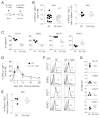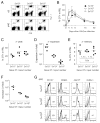Modulating numbers and phenotype of CD8+ T cells in secondary immune responses
- PMID: 20411564
- PMCID: PMC2993099
- DOI: 10.1002/eji.201040310
Modulating numbers and phenotype of CD8+ T cells in secondary immune responses
Abstract
Prime-boost regimens are frequently used to increase the number of memory CD8(+) T cells and thus the protective capacity of experimental vaccinations; however, it is currently unknown how the frequency and phenotype of primary (1 degrees ) memory CD8(+) T cells impact the quantity and phenotype of secondary (2 degrees ) memory CD8(+) T-cell populations. Here, we show that 2 degrees infections of mice that received different 1 degrees infections and/or immunizations generated similar numbers of 2 degrees effector and memory CD8(+) T cells. Remarkably, this result was independent of the numbers and phenotype of 1 degrees memory CD8(+) T cells present at the time of rechallenge. However, after adoptive transfer of low numbers of 1 degrees memory CD8(+) T cells, a linear correlation between 1 degrees memory CD8(+) T-cell input and 2 degrees memory CD8(+) T-cell numbers was observed. These data suggest that, above a very low threshold, boosting of 1 degrees memory CD8(+) T-cell populations elicits 2 degrees immune responses of similar magnitude. Therefore, our study has important implications for the design of prime-boost regimens that aim to generate protective CD8(+) T-cell-mediated immunity.
Conflict of interest statement
Figures






References
-
- Badovinac VP, Porter BB, Harty JT. Programmed contraction of CD8(+) T cells after infection. Nat Immunol. 2002;3:619–626. - PubMed
-
- Wherry EJ, Teichgraber V, Becker TC, Masopust D, Kaech SM, Antia R, von Andrian UH, Ahmed R. Lineage relationship and protective immunity of memory CD8 T cell subsets. Nat Immunol. 2003;4:225–234. - PubMed
Publication types
MeSH terms
Substances
Grants and funding
LinkOut - more resources
Full Text Sources
Medical
Research Materials

